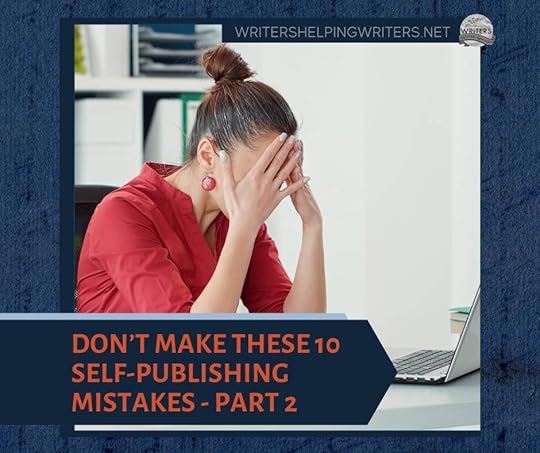Don���t Make These 10 Self-Publishing Mistakes – Part 2

By Sarah Kolb-Williams
In part one, we looked at a few production mistakes new authors can make. Today, we���ll focus on mistakes to avoid while finalizing your files and publishing your book.
6. Skipping the EbookIf you love holding printed books, you might assume your readers feel the same way. But if you���re considering skipping an ebook entirely, think again.
A 2022 report by the Pew Research Center revealed that nearly one in ten readers read exclusively ebooks. That may be just a slice of the pie, but shouldn���t your book be available to everyone?
Publishing a Kindle version of your book with KDP gives you other important benefits:
 You can list your ebook on Kindle Unlimited.With two sets of keywords and categories to work with, you can double your optimization potential (more on that later).Amazon reviews for one format automatically transfer to the other.
You can list your ebook on Kindle Unlimited.With two sets of keywords and categories to work with, you can double your optimization potential (more on that later).Amazon reviews for one format automatically transfer to the other.You���ve worked hard on your manuscript. You���ve gone through multiple rounds of revisions. You���ve had your book designed, edited, and proofread (right?). For most authors, it makes sense to maximize that time, money, and energy by releasing multiple formats.
7. Not Owning Your ISBNsIf you publish through KDP, you have the option to use a free ISBN. But should you?
If you���re only ever planning to publish on Amazon, and if spending $250 for two ISBNs���one each for your print book and ebook���is a financial burden, go ahead and use KDP���s free ISBNs. But understand that other distributors can���t use those ISBNs, and Amazon (not you) will be listed as the publisher on record.
If you later decide to ���publish wide��� with other retailers, you���ll need to create a whole new edition. At the very least, this means a new cover, a new copyright page���and a new ISBN for each format. Suddenly, that ���free��� ISBN has cost you a lot of time, money, and frustration, and you ended up having to buy your own anyway. To keep your distribution options flexible, buy your own ISBNs to begin with.
(Pro tip: If you even suspect that you���ll publish another book or format, grab a block of ten ISBNs from Bowker for $295 right off the bat. Three hundred bucks isn���t nothing, but it���s not much more than the cost of two individual ISBNs, and you���ll be covered for up to eight more formats, editions, or titles.)
8. Failing to OptimizeOptimizing your sales description may sound intimidating, but it���s easier than you might think���and it can mean the difference between online success and total oblivion.
For book listings, optimization comes down to three key elements:
good keywordsgood categoriesgood metadataSo what makes a keyword ���good���? The sweet spot here is finding terms that are appropriate for your book and have a high search volume but a low use volume. In other words, lots of people are using them to search for books like yours, but they aren���t finding much. That���s where your book comes in!
What makes a category ���good���? Same principle: categories that are appropriate for your book, but that don���t have so much competition that you���ll never have a shot at climbing the ranks.
What makes metadata ���good���? This means you���re filling the back end of your book listings with information that accurately describes your book and makes sense to anyone looking for books like yours.
Many authors simply fill in the fields marked ���required��� and leave the rest blank, but that doesn���t help them get discovered. Look for opportunities to add all the useful information you can when you set up your book listings, and you���ll give your book the best shot at being found by your ideal readers.
9. Not Understanding Book Distribution
Here���s the hard truth: with nearly 11,000 books published every day, seeing your book on the shelves of stores like Barnes & Noble just isn���t the reality for most independent authors. Before you decide on a distribution plan, be realistic about your goals.
Even if you can get them interested, most corporate retailers will expect to order your book through standard channels at a wholesale discount of 55%. They���ll also expect the ability to return unsold copies of your book. That discount can seriously cut into your margins, and a mess of unexpected returns can wreak havoc on your accounting.
But think about it: today, many readers shop primarily online for books. For most new authors, the best distribution strategy is meeting those readers right where they are: online. If you���re focused solely on online sales to individual consumers, there���s no reason to set a steep discount or make your book returnable.
The good news is that you can always change your discount and return status later. For now, consider your current goals, and plan your distribution accordingly. Remember, they���re your goals and no one else���s.
(Pro tip: Check that the trim size you���re interested in is compatible with your chosen distribution plan before you start working with a book designer.)
10. Skipping the Post-Publishing TasksPublishing your book might feel like crossing the finish line, but in many ways, the race is only just beginning.
After you celebrate (and turn your computer off for a while and get some well-deserved sleep), here are a few extra steps to consider:
Sign up for Author Central through your KDP account and create your Author Page. (This is also the place to add any editorial endorsements your book has received.)If you haven���t already, set up an author website with a book page, about page, and newsletter sign-up form.Consider ads to increase your sales. Many distribution and social media platforms offer ad packages to increase visibility and encourage readers to buy your book.If you decide to purchase ads, track your numbers carefully to find the right spend amount and ensure the cost of your ads is worth the ROI. (ScribeCount and Publishwide are two low-cost options that can make this task easier.)Don���t stretch yourself too thin on social media. To begin with, focus on the networks you���re most comfortable with, show up consistently, and don���t post only about your book.Sign up for HARO (Help A Reporter Out). Many reporters and bloggers use HARO to find experts to interview about topics they���re writing about. You could be one of them!Try using Google Alerts, Giga Alert, or another web monitoring tool so you know when your name or book title is mentioned.Self-publishing on your own can be intimidating, but it doesn���t need to be. Avoid these mistakes, and you���ll be off to a successful and enjoyable publishing journey that leaves you with the flexibility to control your author career.
Do you have any self-publishing questions?
Sarah Kolb-Williams has been a freelance editor and writer for over fifteen years. She is currently lead editor at Spoonbridge Press, a small publishing services company she cofounded to help independent authors navigate the confusing world of self-publishing. When she���s not working with independent authors, she���s relaxing with her family, enjoying the local live music scene, or tracking down the spiciest food she can find.
The post Don���t Make These 10 Self-Publishing Mistakes – Part 2 appeared first on WRITERS HELPING WRITERS��.
Writers Helping Writers
- Angela Ackerman's profile
- 1022 followers



